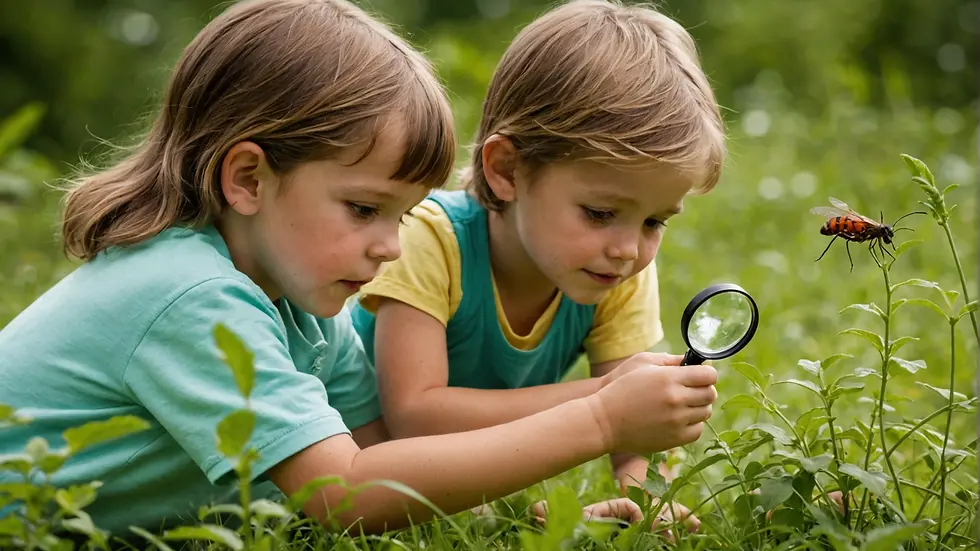Exploring the Tiny World: Sensory Insect Adventures for Young Explorers in Preschool Daycare
- Mum N Kids Management
- Oct 29, 2024
- 4 min read
Have you ever paused to think about the amazing miniature universe that lies right at our feet? The world of insects is a vibrant and diverse realm that can ignite curiosity and inspire learning in young children. If you are a parent of a toddler in a preschool or daycare setting, especially one that embraces the Reggio Emilia approach, this is an excellent chance to introduce your little ones to this magical domain. In this post, we will explore how to carry out fun sensory insect adventures that can enhance early science learning, spark curiosity, and foster a sense of wonder.
The Wonders of the Insect World
Insects stand out as one of the most varied groups of animals, with over 1 million described species buzzing, crawling, and fluttering all around us. Each insect presents a unique shape, size, and texture, making them captivating subjects for exploration. Engaging with this tiny world can spark a lifelong passion for nature and science in your children.
One fascinating aspect of observing insects is their size variation. Some insects, like butterflies, are easily recognized for their beauty, while others, such as ants, often go unnoticed. Encourage your child to use a magnifying glass to turn a walk in the garden into a thrilling expedition. For example, kids could discover a butterfly's intricate wing patterns up close or notice the tiny hairs on an ant's body, expanding their understanding of the world around them.
Sensory Touch: Engaging with Textures
A hands-on approach is vital in helping young children develop a passion for learning. The tactile experience of touching, observing, and investigating is essential in early learning environments. When introducing insects, transform the experience into an engaging tactile journey!
Use a butterfly net to gently catch insects or encourage children to search for them in grassy areas and beneath leaves. Invite them to feel various textures by comparing plants to the insects that inhabit them. For instance, the glossy surface of a ladybug's shell can be compared with the rough texture of a tree's bark or the delicately soft feel of a butterfly’s wings. Research indicates that engaging multiple senses can enhance memory retention in young learners by up to 70%.

The Magic of Magnification
One of the most thrilling aspects of exploring the insect world is using a magnifying glass to unveil minuscule features. With this simple tool, a child's perspective changes dramatically as they discover tiny creatures that come to life before their eyes.
Encourage your children to examine the intricate features of an insect, noticing details like segmentation, patterns, and colors. You could discuss the purpose of specific traits: for instance, how bright colors in some insects can serve to warn predators, or how a beetle’s hard shell protects it from danger. By introducing scientific vocabulary and concepts, you can enhance their learning experience while aligning with preschool science curriculum goals.
Discovering Insect Habitats
As budding explorers delve further into the world of insects, they can learn about the environments where these creatures reside. Insects can thrive in various habitats—from lush gardens to backyard flower pots. Understanding these ecosystems helps children visualize how insects interact with their surroundings.
Consider organizing a simple habitat project. Gather leaves, soil, and small twigs to create a mini habitat, placing it in a safe spot for observing. Encourage your children to note the types of insects they spot, their behaviors, and how they use their environment. For instance, they may see ants tirelessly carrying food back to their underground homes or butterflies flitting from flower to flower, illustrating their essential role in the ecosystem.
Learning Experience and Scientific Discovery
Exploring the insect world fosters a sense of discovery that is invaluable in early childhood education. As toddlers observe variations in size, color, and texture, they gain scientific knowledge alongside critical skills like observation and categorization.
Sharing these experiences in group settings can also enhance social skills. Whether in preschool, daycare, or on family trips, discussing insect adventures with friends or siblings fosters an environment of shared wonder.
Taking inspiration from the Reggio Emilia approach—centered on learning through play—encourage children to ask questions about their tiny discoveries. Why do ants work together? How do bees produce honey? Engaging in these discussions promotes critical thinking, and you'll undoubtedly feel a sense of pride as your little ones transform into inquisitive explorers.

Embrace the Exploration
Diving into the captivating world of insects provides a remarkable opportunity for young children, especially toddlers in preschool or daycare settings, to meaningfully engage with their environment. Through sensory experiences, magnification, and hands-on discovery, they gain insights into nature that ignite their curiosity and nurture a lifelong love for learning.
So, equip yourself for your next outdoor adventure! Grab your magnifying glass, step outside, and let your children embark on an exploration of the tiny world of insects. They will delight in the excitement of discovery, while you help nurture their scientific minds, giving them the tools they need to explore the fascinating details of life all around them.

Happy bug hunting!


Comments